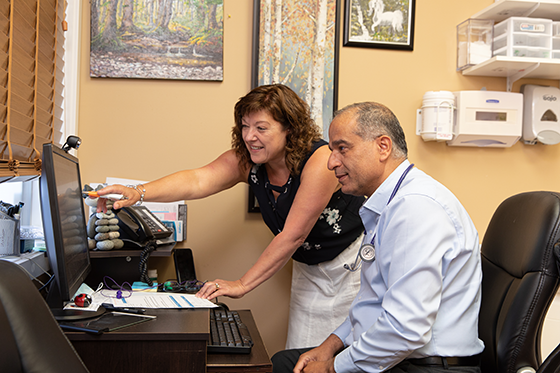The impact of the COVID-19 pandemic has been felt across the world. Throughout its challenges and tragedies, the pandemic has also been a catalyst for positive effects.
For one clinic in a small town on Vancouver Island, the pandemic sparked the transformation in how it delivers care to its patients.
“Before COVID-19, my clinic was not offering any form of virtual care. All visits were in person,” tells Dr Ashraf El Karsh, a family physician in Qualicum Beach. “The pandemic changed everything, and we had to change as well –and move quickly.”
Without hesitation, Dr El Karsh started to offer his patients phone visits and then he added video visits by enabling the video capability in his EMR and using Zoom for Healthcare, which had a free license offered by the Doctors Technology Office (DTO) and the Provincial Health Services Authority. To mitigate difficulties for patients, staff spent about five minutes with patients who needed more help with the change.
“Generally, everyone is happy with the process. Some elderly patients in my practice do experience difficulties with video, and in these cases we offer an appointment by phone,” says Dr El Karsh.

A learning journey
Interested in optimizing the use of technology in his practice, Dr El Karsh attended a webinar series about video-based virtual care that was led by his colleague and peer mentor Dr Mark Morris. The series is offered in partnership by the Central Island Division of Family Practice and the GPSC through the DTO and Practice Support Program (PSP).
His participation in the three-part series helped Dr El Karsh learn about virtual care modalities, tools and resources, and inclusion with in person care. Motivated and inspired to apply what he had learned in the webinars, Dr El Karsh sought coaching and mentoring support by connecting with Suzanne Beyrodt-Blyt, a member of PSP’s regional team who had worked with the practice on quality improvement projects in the past.
With the help of Suzanne, Dr El Karsh and the practice team developed and actioned a plan to update patient contact information, such as email addresses that enabled the clinic to efficiently send general clinic information and COVID-19 updates to patients, and to implement a new workflow to get patient consent for electronic communications and virtual care including video appointments.
In the webinar sessions, Dr Morris had explained how to record a verbal consent and how to verify the consent documentation in a patient’s chart. Dr El Karsh took this back to his practice; he created and implemented a new template in his EMR that enabled him to see an alert each time he was in a patient’s chart. Dr El Karsh notes this as an efficient way to know which patients he has already talked to about this and for patient charting. The EMR also helps track how many patients have consent on record.
Dr El Karsh continues to add more functionality to his EMR including a signing pad for wet signatures. “This was a big improvement for just about $40. It makes a lot of sense considering how much I use it.
Fast forward a year
In about one year, the clinic went from providing zero virtual visits to about half, including for some elderly patients who prefer to visit virtually for care such as prescription renewals and blood sugar levels. Dr El Karsh notes that videoing also helps him assess patients as he can consider their visual behaviour/cues. Acknowledging that the current billing is helpful, Dr El Karsh plans to sustain this level of virtual care if MSP fees continue to be available. Doctors of BC is in discussions with the provincial government regarding virtual care fees post-pandemic.
The clinic also reports that about five to 10% of virtual visits are rescheduled for an in-person visit based on the doctor’s judgement during the virtual visit.
Not only have these changes increased the physician’s self-reported productivity and connection with specialists, but they have also increased the clinic’s capacity by 10% and saved the clinic about 5,000 sheets of paper per month by switching to an e-faxing platform with support from DTO.
With its many benefits, including enhanced access to care, virtual care is certainly a positive outcome from the pandemic. It’s critical that it is balanced with in-person care which continues to be of paramount importance in primary care.
"It is important to maintain quality of care at the same level as with in person care,” shares Dr El Karsh. “Besides sometimes I feel I miss the link and human touch.”
